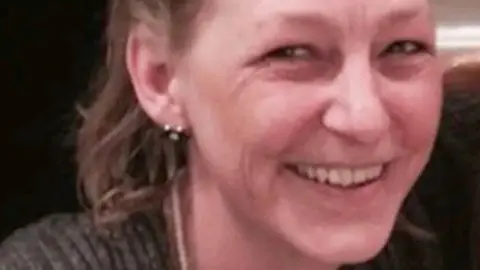
 Metropolitan Police
Metropolitan Police
Dawn Sturgess, 44, died in July 2018 after coming into contact with nerve agent Novichok
A police officer who wrongly described Novichok victim Dawn Sturgess as a "well-known drug addict" has apologised.
Wiltshire Police's temporary Supt Kerry Lawes told an inquiry into Ms Sturgess's death that "there was no intelligence" to support the comment.
Ms Sturgess died on 8 July 2018 after being exposed to the nerve agent, which was left in a discarded perfume bottle.
The inquiry heard last week how a former Russian spy and his daughter, who were poisoned with the substance months earlier, were initially suspected to have suffered an opioid overdose.
Both Sergei Skripal and his daughter Yulia survived their exposure to the substance, as did then-police officer Nick Bailey.
Ms Sturgess's boyfriend Charlie Rowley, who had unwittingly given her the bottle containing the killer nerve agent, also survived the incident.
Previously, the Sturgess inquiry heard that paramedics who attended to Mr Rowley formed a view he was suffering from nerve agent poisoning, but the police disagreed with them.


Ms Sturgess was exposed to the nerve agent after Mr Rowley gave her a discarded perfume bottle he had found
The inquiry heard that Mr Rowley was known to Wiltshire Police as a drug user.
While Wiltshire Police's Chief Constable Catherine Roper previously apologised for Ms Sturgess being described as a "known drug user", Monday was the first time Ms Lawes had apologised publicly.
In an email sent to the coroner on July 1, before Ms Sturgess’ death, she said the police had received a report of a possible nerve agent poisoning, which she believed was a drugs overdose.
'Unprofessional comment'
In the email Ms Lawes, who was a Det Sgt at the time of the poisoning, said the ambulance and fire brigade who attended the scene had “panicked somewhat”, adding that Ms Sturgess and Mr Rowley were “two well-known drug addicts”.
Ms Lawes, who could not attend the inquiry in person, apologised for saying the ambulance and fire service had "panicked".
“I have stated the ambulance and fire panicked somewhat, this was an unprofessional comment to make and I would like to take the opportunity to apologise for it,” she said.
In a written statement read out to the inquiry earlier, Ms Lawes said the belief that the incident was drugs related was influenced by information she had received from police.
She also apologised for writing that Ms Sturgess was an addict.
“I now know there is no intelligence to support the assertion that Dawn Sturgess was herself a user of illegal drugs or an addict,” she said.
She added that she had always acted in good faith and based on what she thought was in the best interests of the individuals involved.
'Bad batch' of drugs
Det Sgt Eirin Martin also gave evidence to the inquiry.
She received a handover on the case from then-detective sergeant Lawes on July 2.
She said the police’s initial hypothesis was that Ms Sturgess and Mr Rowley had ingested drugs cut with pesticides, and this had caused them to overdose.
Because of this hypothesis, she asked Wiltshire Police’s media team to send out a press release on July 2 warning of a potential “bad batch” of drugs.
“At the point I made the press release in relation to the contaminated drugs that was, at that point, the primary hypothesis,” she said.
The inquiry continues.





 2 weeks ago
6
2 weeks ago
6









